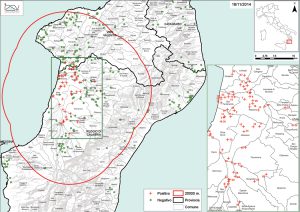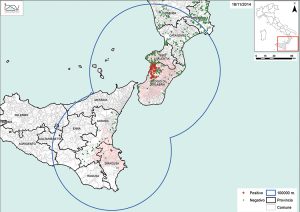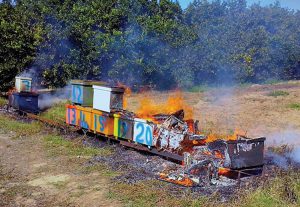Italy and Small Hive Beetles
By: Andrea Quigley
Italian beekeepers are in despair with the discovery that small hive beetle (‘SHB’, Aethina tumida) has arrived on their shores. On 5 September 2014(1,2), Prof Vincent Palmeri(3) found adult small hive beetles in a bait hive at the Department of Agriculture, the Università Mediterranea, Calabria, near the port of Gioia Tauro in Southern Italy. On 11 September(4,5), the outbreak was officially confirmed by the team lead by Dr Franco Mutinelli of the National Reference Centre for beekeeping of the Istituto Zooprofilattico Sperimentale delle Venezie (IZSVe). On 7 November(5,6), beetles were found in Sicily. These outbreaks are not the first assault made on Europe by SHB which previously was found in Portugal in 2004. That time it was successfully and speedily eradicated. This time the situation is not so hopeful.
No one is absolutely certain, but it is thought that the beetle arrived on rotting fruit imported into the port of Gioia Tauro(2). On confirmation of the infestation, the Ministry of Health in Rome(2,4) immediately issued control orders to restrict all movements of hives within a 20km (12.4 miles) radius immediately surrounding the university. A monitoring and surveillance zone with a radius of 100km (62.1 miles) was also set up.
Beekeepers and local veterinarians are now required to monitor all apiaries closely and to contact Bee-net, the national Italian bee monitoring system should they suspect the beetle is present. The first bait hive was fumigated and frozen(2). At all the subsequent discoveries of SHB, the soil surrounding the affected apiary is fumigated and the colonies burned with a view to eradicating this pest.
Beekeepers whose apiaries have been destroyed have not yet been offered any compensation but a ministerial order is at last in the hands of the Italian Court of Auditors for approval(7). It is probable that an announcement will be made after this article is written.
The maps provided by the IZSVe national reference laboratory for Beekeeping in Italy show the site of the initial outbreak in September. Two months in, the map includes Sicily. The red marks were sites where affected apiaries were found and destroyed. After two months 56 infested apiaries had been confirmed. In some cases, a second case has been reported at what was considered to be a treated site. This suggests the eradication is not always as effective as hoped(5,7). It is a huge undertaking. By 28 October, over 12,000 hives had been inspected in some 463 apiaries(8) and the number of apiaries inspected continues to rise. Many apiaries have been confirmed as clear of the pest (shown on the maps as green dots). The control areas are also shown on each map, the inner ring being the protection and control zone, and the outer being the surveillance zone where increased monitoring is taking place.
Franco Mutinelli(9,10) has reported directly to the European Commission on the cases found. His team has been working with the European Reference Laboratory for bee health at ANSES (Agence Nationale de Sécurité Sanitaire de l’Alimentation, de l’Environnement et du Travail or French Agency for Food, Environmental and Occupational Health & Safety) Sophia-Antipolis, France, to develop health measures provided under EU law. To satisfy EU safeguards and the law, the Italians have also measured the extent of the outbreak, tracing all hive movements and sales of bees. The EU is drafting a ban on movements of bees and hive products from Calabria for a minimum of eight months(9).
Italian beekeepers have benefited from U.S. expertise with wide circulation of a training video from prof. Jamie Ellis, University of Florida(11), together with in-depth interviews with prof. William Hood, Clemson University(12), and Jeff Pettis, ARS- USDA(13). Jeff Pettis has also worked closely with the Italian authorities and given guidance on use of diagnostic aids(14).
The Italian ligustica strain of Apis mellifera is thought to have originated in Italy and northern Sicily. Famous for its productivity and gentle nature, and benefitting from the warm Mediterranean climate, the Italian bee industry was valued by the Federazione Apicoltori Italiani in 2008(15) as exceeding €1 billion (about US$1.24 billion using today’s rates). Italian beekeepers supply queens and package bees throughout Europe as well as honey and hive products. Calabria is a region with numerous beekeepers who migrate their colonies to fulfil pollination contracts as well as having (until now) bee breeders who supplied queens and package bees.

Map of the Small hive beetle outbreak on 18 November. Confirmed cases are indicated by red crosses, “clean” apiaries by green spots. The 10 km control zone is shown. Source – National Reference Centre for beekeeping of the Istituto Zooprofilattico Sperimentale delle Venezie (ISZVe)
Luciano Scandian(16) is an Italian beekeeper and member of the honey bee research team in the Laboratory of Apiculture and Social Insects at the University of Sussex, UK. He returned from a vacation with his beekeeping family in Veneto, North East, Italy, shortly after the outbreak was announced. While there, he attended a number of beekeeping meetings and gave lectures on Varroa control at two of them. He told me the beekeepers he met ranged from being “scared stiff” to “extremely worried” and the general consensus was “it is only a matter of time” before the beetle makes its way across Italy. There was widespread concern that a block on all hive movements throughout Italy might become necessary.
In nearly all cases only adult beetles have been found. Using the latest available data(17), only four colonies held larvae and only one contained pupae out the 58 known cases. Prior to the discovery of the beetle in Sicily, Franco Mutinelli said, “Our inspections have shown us that the beetle is found in strong bee colonies as well as weak ones, in freshly made combs as well as old ones, and in nucleus colonies as well as full colonies. However, until now the infestation appears limited to this area of Calabria region(18)”.
Yet many Italian beekeepers are fearful that (1) the beetle was present before September and (2) not all Calabrian beekeepers honoured the standstill order when it first came into force.
Notwithstanding the fears and rumours, Varroa is a major problem for Italian beekeepers without any definitive controls available. Many Italian beekeepers are unhappy that as well as coping with Varroa, they now need to rely on traps to find the beetle but have no real idea what to do should they find it, other than to call the authorities who will destroy their apiaries. Many beekeeping groups have covered SHB in their recent meetings and newsletters. As Luciano Scandian said, “A lot of it is fear of the unknown. Small Hive Beetle is yet another problem for beekeepers with no real treatments available. In truth, we simply don’t know what is going to happen(16).”

Map of the Small hive beetle outbreak on 18 November including Sicily. Confirmed cases are indicated by red crosses, “clean” apiaries by green spots. The 20 and 100km control zones are shown. Source – National Reference Centre for beekeeping of the Istituto Zooprofilattico Sperimentale delle Venezie (ISZVe)
In the quest to eliminate the beetle, every single colony in an infested apiary is burned, even if it only one colony has SHB. 2,123 colonies and three wild swarms had been destroyed by 28 October(9). Since then, that number has risen as more cases are found. Not surprisingly, many Calabrian beekeepers are concerned that their industry is being destroyed systematically. Beekeeping groups(19,20,21,22,23) and the Calabrian Ministry for Agriculture and Forestry(24), together with other interested parties like the Slow Food movement(25), have written to the government in Rome calling for formal acceptance that establishment of the pest in their region is now inevitable. They demand the control measures should shift from eradication to those enabling beekeepers to retain their colonies as they need to learn to live alongside small hive beetle. An independent group called “Salviamo le api” (“Save the bees”) claim more than 3,000 hives have been burned and, like the other groups, they want the burnings to stop(26). In addition to the bee keepers, the Slow Food movement(25) and other environmental organisations have voiced their fears that the loss of bees will create a pollination crisis in southern Italy.
Meantime the members of international honey bee protection network COLOSS have set up a special task force on SHB(27). President of COLOSS, Prof. Peter Neumann said, “The COLOSS association is greatly concerned about this discovery, which probably represents the permanent arrival of this pest into Europe. There is therefore a risk that it will spread to other European countries, but we cannot yet predict what its effects on the beekeeping industry and other bees might be. COLOSS members will work together to bring scientific results into practice for the benefit of beekeepers to help them fight this serious pest(18).” I understand COLOSS is planning with the International Bee Research Association to hold a workshop in Italy early in 2015(27).
 The spread of this pest was hoped to be contained in Calabria but on 7 November it was confirmed that beetles had been found in nearby Syracuse district(4,6). Syracuse is on the island of Sicily, less than 75 miles (119 km) from Calabria. The authorities hope that the increased monitoring will mean this is the only case ever to be found on the island. No other cases have been found to date in Sicily other than those on another part of that infested apiary(7). Notably, the beekeeper with the infested Sicilian apiary is based in Calabria where he keeps other bees.
The spread of this pest was hoped to be contained in Calabria but on 7 November it was confirmed that beetles had been found in nearby Syracuse district(4,6). Syracuse is on the island of Sicily, less than 75 miles (119 km) from Calabria. The authorities hope that the increased monitoring will mean this is the only case ever to be found on the island. No other cases have been found to date in Sicily other than those on another part of that infested apiary(7). Notably, the beekeeper with the infested Sicilian apiary is based in Calabria where he keeps other bees.
At present, the rate of new cases seems to be tailing off. It is hard to tell whether this reflects the effectiveness of the “scorched earth” policy being followed or is merely a reflection of the time of year. Of some concern is the spread of the hive beetle to wild honey bee colonies and to bumble bees(9). So far, only three infested feral honey bee colonies have been found and destroyed. Yet as in the U.S., Europe is passing into winter so this is not a time of year when swarms are abundant and swelling the number of wild colonies. In Calabria, the beekeeping season starts in January as the orange trees bloom. Should the Italians fail to have the small hive beetle eradicated before the New Year then the incidences of beetle will likely start to increase.
References
1. Palmeri, V; Scrito, G; Malacrino, A; Laudani, F; Campolo, O (2014) A new pest for European honey bees: first report of Aethina tumida Murray (Coleoptera Nitidulidae) in Europe. Apidologie (in press).
2. A.tumida: Il piccolo coleottero dell’alveare è in Italia http://www.federapi.biz/index.php?option=com_content&task=view&id=1257&Itemid=0
3. A. tumida: Rogo totale, si bruciano gli ultimi alveari http://www.federapi.biz/index.php?option=com_content&task=view&id=1290&Itemid=0
4. A. tumida: Epidemiological situation http://www.izsvenezie.it/index.php?view=article&catid=119%3A-beekeeping&id=1731%3Aaethina-tumida-epidemiological-situation&format=pdf&option=com_content&Itemid=629
5. Mutinelli, F; Montarsi, F; Federico, G; Granato, A; Ponti, A M; Grandinetti, G; Ferrè, N; Franco, S; Duquesne, V; Rivière, M-P; Thiéry, R; Hendrix, P; Ribière-Chabert, M; Chauzat, M-P (2014) First report on the detection of Aethina tumida Murray (Coleoptera: Nitidulidae.) in Italy. Journal of Apicultural Research 53(5): (in press). http://dx.doi.org/10.3896/IBRA.1.53.5.08
6. A. tumida: Dalla Calabria alla Sicilia, parassita nomade aethina tumida 2014 http://www.federapi.biz/index.php?option=com_content&task=view&id=1299&Itemid=0
7. A. tumida: Focolaio Siciliano “Chiuso”, Calabria negativa 2014 http://www.federapi.biz/index.php?option=com_content&task=view&id=1301&Itemid=0
8. A tumida: Report di F. Panella su incontro a Catanzaro http://www.mieliditalia.it/index.php/sanita-degli-alveari/81666-atumida-report-di-fpanella-su-incontro-a-catanzaro
9. Presentation: A. tumida (Small Hive Beetle) notified in Calabria region, southern Italy Franco Mutinelli, Brussels, 19 September 2014 http://ec.europa.eu/food/committees/regulatory/scfcah/animal_health/docs/20140919_aethina_italy.pdf
10. Presentation: A. tumida (Small Hive Beetle) outbreaks in Calabria region, southern Italy Franco Mutinelli, Brussels, 6 October 2014, http://ec.europa.eu/food/committees/regulatory/scfcah/animal_health/docs/2014100607_aethina-tumida_italy.pdf
11. A. tumida: un video per spiegare cosa è e come si controlla 2014 http://www.mieliditalia.it/index.php/sanita-degli-alveari/81651-2014-10-06-18-55-04
12. A. tumida: intervista al prof. Hood 2014 http://www.mieliditalia.it/index.php/sanita-degli-alveari/81655-aethina-intervista-al-prof-hood
13. A. tumida: il CRT Patologie Apistiche intervista Jeff Pettis 2014 http://www.mieliditalia.it/index.php/mieli-e-prodotti-delle-api/notizie-prodotti-delle-api/81641-aethina-il-crt-intervista-jeffery-s-pettis
14. Bande diagnostiche per monitorare A. tumida 2014 http://www.mieliditalia.it/index.php/sanita-degli-alveari/81640-bande-diagnostiche-aethina-tumida
15. Appicoltura poco seria? La FAI scrive al ministry Tremonti e Zaia 2008 http://www.federapi.biz/index.php?option=com_content&task=view&id=524&Itemid=164
16. Luciano Scandian, personal communication
17. Centro di Referenza Nazionale per L’Apicoltura. Casi confermati di A. tumida Situazione aggiornata al 25/11/2014 http://www.izsvenezie.it/images/stories/Pdf/apicoltura/aethina-tumida/2014-11-25/2014-11-25-casi-confermati-it.pdf
18. Press release: The small hive beetle is in Europe to stay COLOSS 2014 http://coloss.org/announcements/the-small-hive-beetle-is-in-europe-to-stay
19. A. tumida: ConApi /Unnapi lettera alle autorità 25/10/14 http://www.mieliditalia.it/images/Aetina/Lettera_Unaapi-Conapi_Aethina_Tumida.pdf
20. Lettera di FAI-Calabria http://www.federapi.biz/images/Aethina%20tumida/scarafaggi%20e%20FAi%20Calabria.pdf
21. A. tumida: Un chiarimento sulla Lettera di FAI-Calabria http://www.federapi.biz/index.php?option=com_content&task=view&id=1302&Itemid=0
22. Lettera di FAI 13/11/14 http://www.federapi.biz/images/Aethina%20tumida/FAI_Posizione_Ufficiale_Aethina.pdf
23. A. tumida: il documento con la Posizione ufficiale FAI 27/11/14 http://www.federapi.biz/index.php?option=com_content&task=view&id=1303&Itemid=0
24. Dipartimento Agricultura e Forests Regione Calabria – Aethina tumida: lettera alle autorità 23/10/14 http://www.mieliditalia.it/images/Aetina/Nota_direttoriale_18842_DGSAF_Aethina_tumida.pdf
25. Slow Food: che ne sarà dell’impollinazione se si sterminano le api per Aethina? 2014 http://www.mieliditalia.it/index.php/sanita-degli-alveari/81675-2014-11-11-10-02-20
26. Dagli apicoltori di Calabria (CHIARO E FORTE): FERMATE I ROGHI D’API! 2014 http://www.mieliditalia.it/index.php/sanita-degli-alveari/81693-dagli-apicoltori-di-calabria-chiaro-e-forte-fermate-i-roghi-dapi
27. Norman Carreck, personal communication






